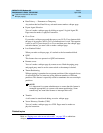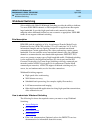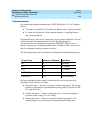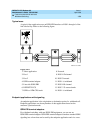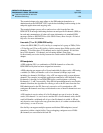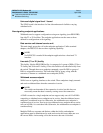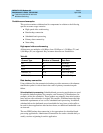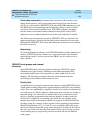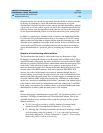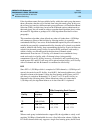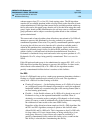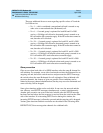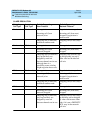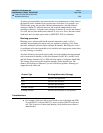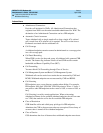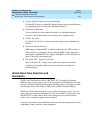
DEFINITY ECS Release 8.2
Administrator’s Guide
555-233-506
Issue 1
April 2000
Features and technical reference
1594Wideband Switching
20
Given this facility list concept, the algorithms have the ability to search for trunks,
by facility, in an attempt to satisfy the bandwidth requirements of a given
wideband call. If one facility does not have enough available bandwidth to support
a given call, or it is not used for a given call due to the constraints presented in the
following section, then the algorithm searches the next facility in the trunk group
for the required bandwidth (if there is more than one facility in the trunk group).
In addition to searching for channels based on facilities and required bandwidth,
Port Network (PN) preferential trunk routing is also employed. This PN routing
applies within each algorithm at a higher priority than the constraints put on the
algorithm by the parameters listed later in this section. In short, all facilities that
reside on the same PN as the originating endpoint are searched in an attempt to
satisfy the bandwidth of a given call, prior to searching any facilities on another
PN.
Direction of trunk/hunting within facilities
The algorithms have the ability to select trunks from low B-channel to high
B-channel or from high B-channel to low B-channel with an ISDN facility. This is
a per ISDN trunk group option, but infers the direction of search within all ISDN
facilities (or portions of those facilities) administered within that trunk group. This
is necessary so the selection of trunks are not prone to as much glare as they
otherwise would be if trunks were chosen in the same direction by both user and
network sides of the ISDN interface. Note that in previous DEFINITY ECS
releases, the order in which trunks were selected, whether through linear or
circular hunting, would always be with respect to the order in which trunks were
administered within the trunk group. Now, with the support of wideband services,
all trunks within an ISDN trunk group optioned for wideband are ordered based
on this new “direction of trunk/hunt with facilities” parameter, and without regard
to the order in which trunks are administered within the trunk group. If an ISDN
trunk group is not optioned for wideband, then a cyclical trunk hunt based on the
administration of trunks within the trunk group is still available.
H11
When a trunk group is administered to support H11, the algorithm to satisfy a call
requiring 1,536 Kbps of bandwidth uses a fixed allocation scheme. That is, the
algorithm searches for an available facility using the following facility-specific
channel definitions.
■ T1: H11 can only be carried on a facility without a D-channel being
signaled in an NFAS arrangement (B-channels 1-24 are used).
■ E1: Although the 1,536-kbps bandwidth could be satisfied using a number
of fixed starting points (for example, 1, 2, 3, etc.) the only fixed starting
point being supported is 1. Hence, B-channels 1–15 and 17–25 are always
used to carry an H11 call on an E1 facility.



